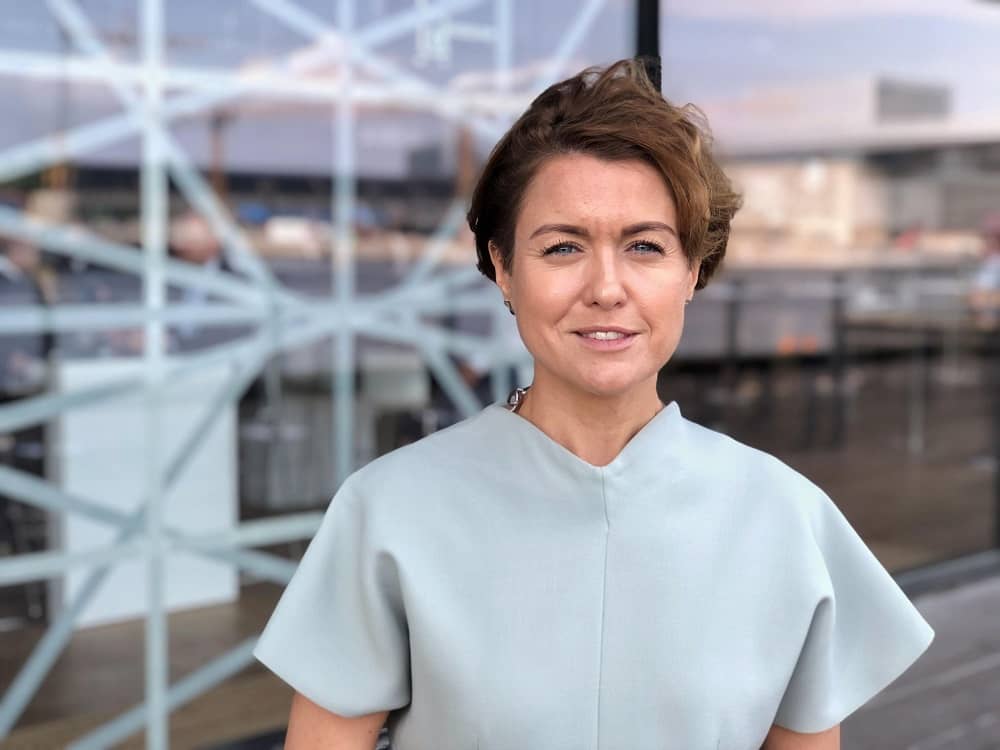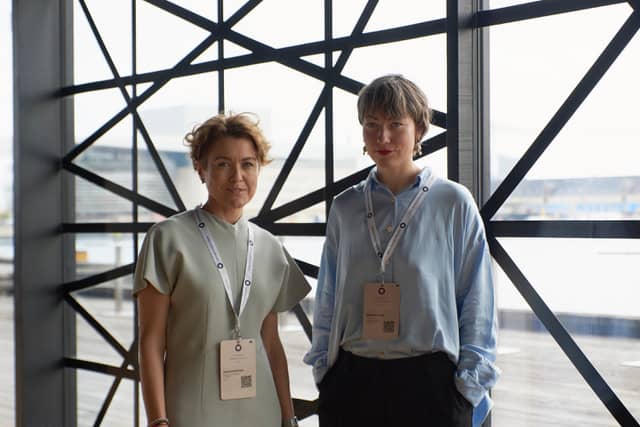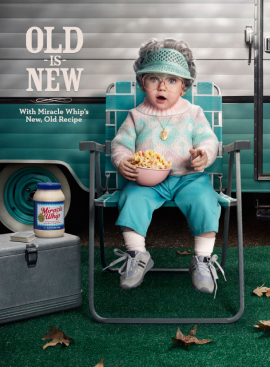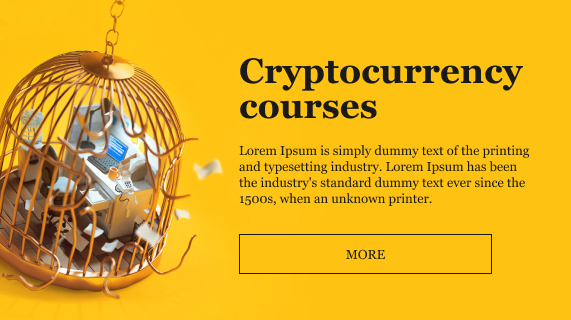- Home
- Publications
- Society
- The Theory of Protection installation at the Copenhagen Democracy Summit: an act of solidarity with Ukrainians
08:02
10 °C
EUR/USD
1,08
GBP/USD
1,28
Ons
$1876,74
The Theory of Protection installation at the Copenhagen Democracy Summit: an act of solidarity with Ukrainians
The Theory of Protection art installation by Daria Koltsova, the Ukrainian artist, is displayed at the Copenhagen Democracy Summit, an annual high-level event dedicated to the presentation of the annual Democracy Perception Index and discussions on how to strengthen democracy globally. The art installation is organized by the activists of the Association of Ukrainians in Denmark and sponsored by Bevar Ukraine and the Alliance of Democracies. It will be available for viewing at The Royal Danish Playhouse until June 25, 2022.The 2022 Copenhagen Democracy Summit is taking place on the 105th day of the Russia-Ukraine war - a war that started a few centuries and 8 years ago. Volodymyr Zelensky, the President of Ukraine, addressed the summit virtually on Friday, and a large delegation from the Association of Ukrainians in Denmark and Bevar, a Ukrainian-Danish charity organization, was invited to the event.

The Theory of Protection project is asking for solidarity with Ukrainians who have had to shield their windows from Russian shelling since 2014. The tapes arranged in beautiful patterns can save lives. The patterns remind us how fragile our homes and lives are, how fragile democracy worldwide is, how many joint efforts and connections of people, of the dots, of the stripes, and of the actions together it takes to make the world resilient to the dangers of unfreedom and authoritarianism.
The Theory of Protection art installation was created by Daria Koltsova, a Ukrainian artist from Kharkiv. Her artistic work, which includes installations, performances, and videos, brings together political and personal dimensions. Since the annexation of Crimea by Russia and the war in Donbas in 2014, she has been working on the effects of war and questioning the possibilities of protection and resiliencies.

“After the beginning of the so-called “ active phase of the war” started this year we all felt the ultimate fragility of any guarantees and any stability. And I proposed all my artistic support to tape windows as a simple but visible sign of solidarity with the Ukrainian people fighting every day for a democratic free and happy country. More than 250 diplomatic and cultural institutions joined the art action on 5 continents. Manifesting that’s not a Ukrainian war anymore. It’s a war for democracy and democratic values all over the world. The war between past and future. Unfortunately, art itself can’t stop the war, but people can. We all can, step by step”, commented Darya.

It is symbolic that the putting up of the art installation as part of the Summit was organized by the activists of the Association of Ukrainians in Denmark.
“Ukrainians abroad share the same wounds Ukrainians feel at home and are now on the mission to do anything and everything possible to help Ukraine win, to provide it with protection to the best of their abilities. As their relatives and friends are fighting on the actual battlefields, via cultural diplomacy the Ukrainian diasporas build international solidarity that adds to the Ukrainian resilience. Together we can protect Ukraine. Together we can protect democracy”, highlighted Nataliya Popovych, founder of One Philosophy and co-founder of ‘We Are Ukraine’ platform, who has initiated and coordinated the art installation.

About Darya Koltsova
Darya Koltsova is an artist born in 1987 in Kharkiv, Ukraine. Her artistic work, which includes installations, performances, and videos, brings together political and personal dimensions. Her works succeed in making current geopolitical or social situations sensitive and tangible, by associating their intimate perceptions and their repercussions on individuals. Moving away from an attempt at realistic representation, she gives form to new images, sometimes derived from historical or iconographic research. Since the annexation of Crimea by Russia and the war in Donbas in 2014, she has been working on the effects of war and questioning the possibilities of protection and resiliencies.
Until the outbreak of the war in Ukraine in February 2022, Darya lived and worked in Kyiv and Odesa. Graduated from Kharkiv Academy of Design and Arts in the direction of History and Theory of Arts. Artist, performer, author of installations and media projects, curator. Grand Prix winner of the MUHi 2015 competition for young Ukrainian artists. Nominated for the PinchukArtCentre Prize 2015. In 2017 she received the scholarship of the Minister of Culture and National Heritage of the Republic of Poland "Gaude Polonia". In 2018 she became a finalist in Non-Stop Media IX.

About Theory of Protection
2014 - ongoing.
For now, you must try not to die.
First step: window taping - instructions
- You will need duct tape and a stool if the window is tall. In old tenements, windows are even two and a half meters high. The last fifty centimeters of the window is the vent. This also needs to be taped. It is best if the tape is thick, at least five centimeters wide.
- Tear the tape with your teeth or cut with scissors. Then stick to the glass, first diagonally, from the lower right corner of the window towards the upper left corner, then vice versa. Repeat the same process on the vent.
- Also stick the tape through the center of the glass, joining its frames from bottom to top and from right to left.
- Repeat the patterns in the form of smaller intersections. This creates numerous intersecting patterns from the tape on the glass.
- When finished, secure the tape, and put it back for reuse.
The patterns on the windows are very intricate. Five stripes across, three stripes from bottom to top, two diagonally, would be enough. Meanwhile, those on the windows in Donetsk and Luhansk, Kyiv, and Kharkiv, form intricate ornaments that take a whole day to stick. The carriers of faith in salvation, are both a wound and a bandage. They are beautiful.
When the shock wave from the explosion comes, the windows will vibrate. First, you will hear the impact, a millisecond later you will notice the vibrating movement of the floor and walls, it will pass through your feet and reach the top of your head, you will feel it in every hair on your body. The windows will vibrate. First the frames, then the long windowsills. You will watch as the vibrations pass from the frames to the strips, which fight with all their lifeless being. At this moment, all your attention will be focused only on them. You will see them tense, the tiny cracks in the glass crawling rapidly from edge to center, and tugging at the taped bodies, trying to find a free run to release the explosive energy that lurks within them. It will all take ten or twelve seconds. When the wave is gone, you will stroke the smooth surface of the tape with your hand. You will look out on the street; you will see who is dead.
Second step: protective spell
As you watch The Theory of Protection installation at Copenhagen Democracy Summit you can listen to a special protective spell, which should be pronounced while taping the windows. This is an ancient Ukrainian spell, voiced by Solomiia Melnyk, the lead singer of Dakha Braha band.
With this link, you can listen to the spell in Ukrainian. Below is a translation in English:
Dark and silent night. You sit on a brown horse, on a falcon saddle. You close the cell, doors, pigsties, Orthodox churches, and monasteries. Close my enemies' mouths, eyes, and cheeks.
God our Veles, my word is as hard as this silent hard white stone. Let all hedgehogs, wolves, and animals go around it sideways. Let them not see or hear, let them not do any harm. Most Holy Mother, lead us and we will carry your fame into the world. To Veles, to Mokosh, to Perun Perunowych, to brightness, and to all gods close to us.
Wind gods, protect during the day, at night, at midnight, at dawn, and in the mornings. And save in our sleep.
Step three: waiting
Keep your head down and don’t tempt fate. Don't talk or make noise. Be quiet, don't go out, and don't get into unnecessary discussions. Don't lean out, don't look in the eyes. Pray. Don't stick out your head. Keep your head down. Away from the windows. Huddled, hidden like a mouse under a broom, hidden like a needle in a haystack, crouching like a cobra in the grass, like a viper in grapes. Silent. Invisible. Absent.
In 2017, the project was shown in Warsaw, Poland, as part of the exhibition State of Danger. In the text for the exhibition, Ewa Sułek, the curator of the exhibition, wrote:
“The state of danger is the moment when nothing is happening yet. It is a moment of uncertainty and observation, a moment of vigilance and suspension, a moment of little stabilization. (...) Conflicts also have a second face - quiet and every day, full of small changes, and new practices aimed at adapting to the changed realities of life. The state of emergency in which the inhabitants of Ukraine have lived since 2013 has taken the form of massive-scale warfare. Thus, it is a registration of the new reality in its private (apartment windows), but also in a mass-scale version. The tapes arranged in beautiful patterns can save lives. But they also talk about a wound, a place that hurts, which is still whole but may turn to dust in a moment.”





























